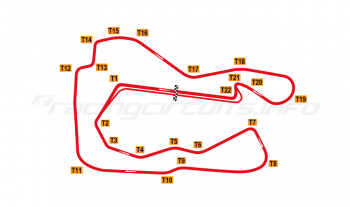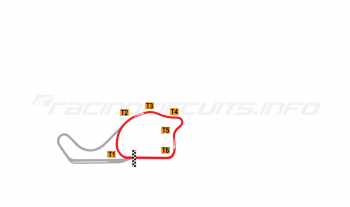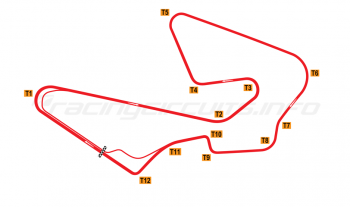Circuit Gilles Villeneuve
Circuit Overview
One of the most relaxed and enjoyable race meetings on the calendar, the Canadian GP has found its long-term home in Montréal, on a circuit now named after the nation's favourite driver, Gilles Villeneuve.
In fact, it was Villeneuve who provided the fans with a fairytale debut victory on the first running of the race in 1978. It was perhaps inevitable therefore that the Circuit Notre-Dame would be renamed in Villeneuve's honour after his untimely death in 1982.
After a coronavirus enforced hiatus in 2020 and 2021, the Canadian Grand Prix returns in 2022.
Circuit History
It was not with motorsport in mind that the man-made island in the St Lawrence Seaway was originally constructed; it was created instead as a venue for Expo '67. The futuristic parkland setting included one of Buckminster Fuller's first domes (remnants of which remain to this day) and a lagoon in the centre.
When Expo vacated in 1968, the site struggled on for years as a standing collection of international pavilions known as "Man and His World." However, as attendance declined, the physical condition of the site deteriorated, and less and less of it was open to the public. However, for the 1976 Olympics, a rowing strip was created alongside and roads were built connecting the various points on the island.

Motorsport arrives and a home hero wins
When the Olympics finished, the island had only a short period of inactivity, as Canadian motorsport needed a new venue for its premier race - and driver - as Mosport had become unsuitable for modern F1 cars.
The IÎe Notre-Dame was thus prepared in double-quick time to a design by Roger Peart for the penultimate race of the '78 season. A capacity crowd, which included Prime Minister Pierre Trudeau, was thus able to spur Gilles onto victory.
Generally popular with the drivers, the circuit was given a few modifications in time for the 1979 to remove initial complaints that the track was too slow. Characterised by twisty sections joined by high-speed straights and tight hairpins, Circuit Gilles-Villeneuve is certainly a test of endurance and braking for the cars. Initially, the pits were located directly after the hairpin at the northern end of the course, with temporary structures leaving the teams exposed to the elements.
The 1982 race was overshadowed by the tragic death of home hero Villeneuve earlier in the season. The track was renamed 'Circuit Gilles Villeneuve' in his honour. The phrase 'Salut Gilles' was painted ahead of the grid, where it remains on view to this day.
Further tragedy was to strike during the Canadian Grand Prix itself, when polesitter Didier Pironi stalled his Ferrari as the race started, being collected at high speed by the Osella of the unsighted Italian rookie Riccardo Paletti. The young Italian was left with serious chest injuries but the car was englufed in flames as rescuers got to him. By the time the fire was out and he was cut free from the wreckage, the hapless youngster was in a critical condition. He died a short time after being airlifed to the Royal Victoria Hospital. He was just two days short of his 24th birthday.
New pits sees startline moved
A lull in activities in 1987 caused by a dispute between sponsors Labatt's and Molson allowed time for a circuit upgrade and new pit facilities to be built further around the lap, while the corners before the Island hairpin were 'smoothed' to form a longer pit straight.
The new layout wasn't without its issues - Derek Warwick crashed heavily during practice at the chicane before the new pits, becoming airborne after he spun on dirt dropped by another car and became airborne over the kerbing. The chiane would be slowed a few years later, partly in response to this crash and others.
World Sportscars come and go as layout changes continue
The 1990 season saw a new innovation, as the circuit played host to the World Sportscar Championship for the one and only time. The event saw the world debut of the Peugeot 905 prototype and the return to racing of ex-F1 champion Keke Rosberg.
In the race itself, there was considerable drama when the powerful ground effects of the Group C cars dislodged a manhole cover, causing a three car crash from which Jesus Pareja was extremely fortunate to escape unharmed, despite his car being engulfed in flames. He was particularly animated afterwards that the marshals had not come to his aid; it was fellow competitor Harri Toivonen whose Courage-Porsche was also caught up in the crash who freed the Spaniard.
In 1994 and 1995, in the heightened safety consciousness post-Senna's death, a temporary chicane was inserted before the Casino curves, making use of what was the exit tarmac for the original pit lane.
More major changes came with the removal of the sweepers on the back straight altogether and further re-profiling of the final chicane - which has certainly proved to be a corner that 'bites', as messers Hill, Villeneuve and Schumacher have demonstrated in recent years! In fact, the chicane is now usually referred to as 'Champion's Corner' and the unyeilding barrier as the 'Wall of Champions'....
Other significant changes came in 2002, with a modification of the pit lane exit into Turn 1, which had itself had seen greater runoff installed. The Turn 10 hairpin was also taken further back towards the Turn 8/9 chicane, allowing a tarmac runoff to be used instead of gravel. The wall at the infamous Turn 15 'Champion's Corner' has also been moved further back and a rubber-belted tyre wall added.
Circuit Gilles Villenueve has in recent years earned a relatively unique distinction, in being one of the few circuits to host Formula One, ChampCar, Grand Am and NASCAR races on the same layout, providing an interesting comparison between the various formulae. Between 2002 and 2006 it was the turn of the ChampCars to take up the second race meeting slot, whereas from 2007 the NASCAR Busch/Nationwide Series held a double card event with Grand Am's Rolex Series.
From 2013 the circuit has reverted to being a Formula One host only, albeit with several support categories, usually including F1600, Ferrari Challenge and the Porsche Cup.
Jump onboard
Circuit info
- Octane, 200 Circuit Gilles-Villeneuve, Race Group Montreal, QC H3C 1A9
- +1 514-350-0000
- Official website
Rate This Circuit
Votes: 7022
Plan a visit
Get your race tickets!
Brought to you with: 
We've teamed up with Motorsports Tickets to bring you the best deals for Formula One, MotoGP, Le Mans and more.

















